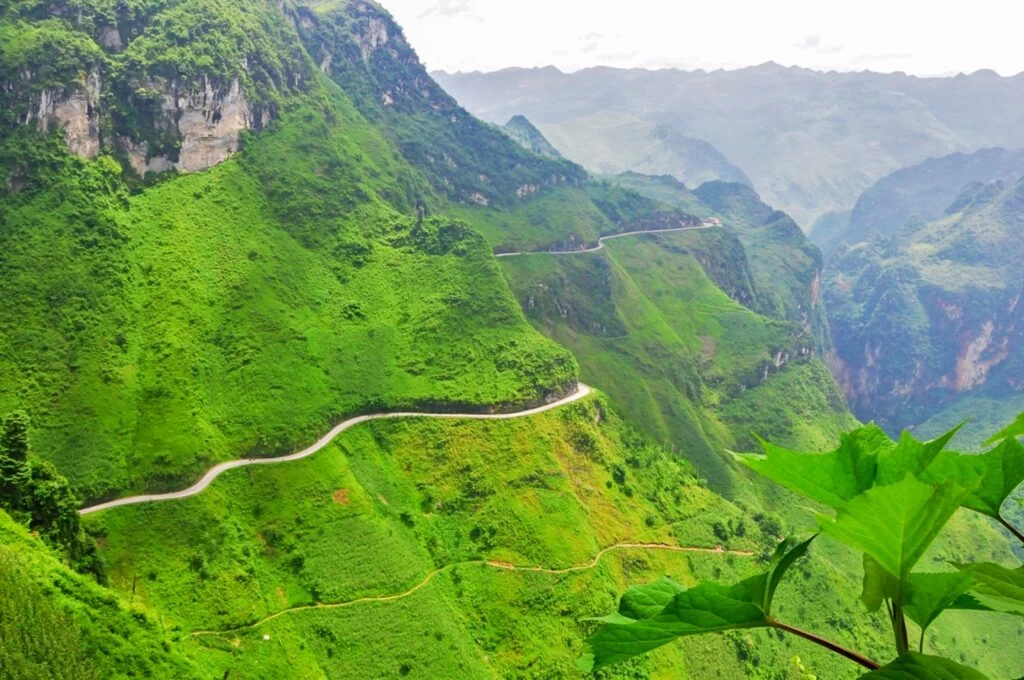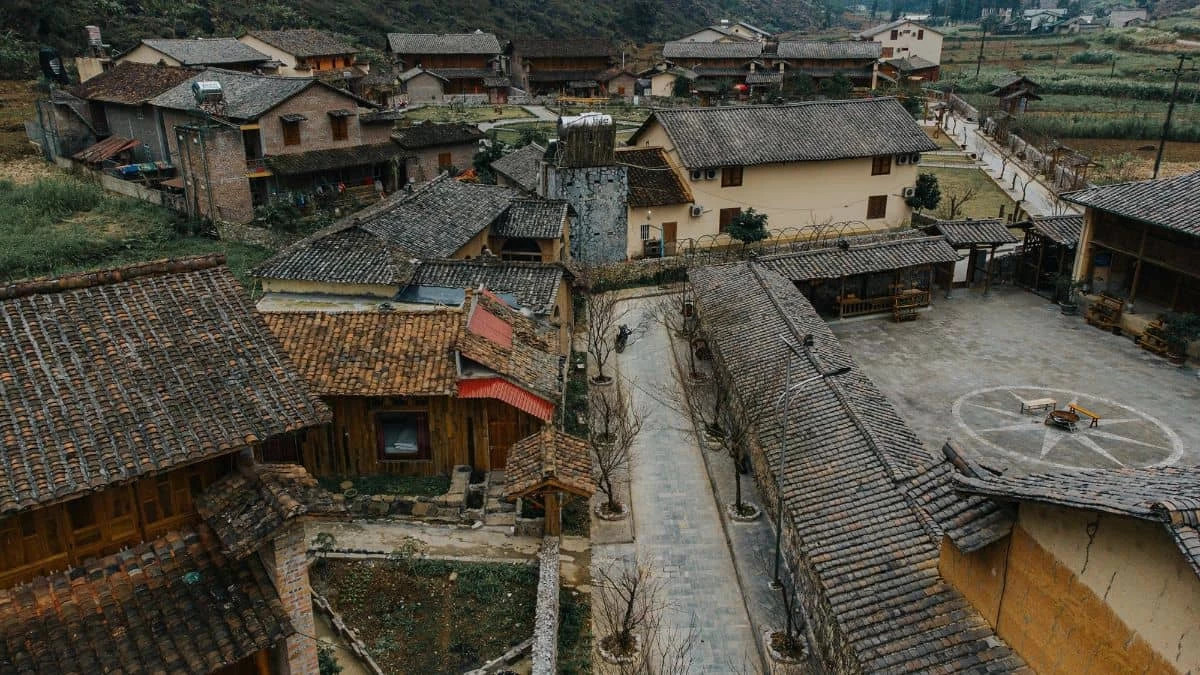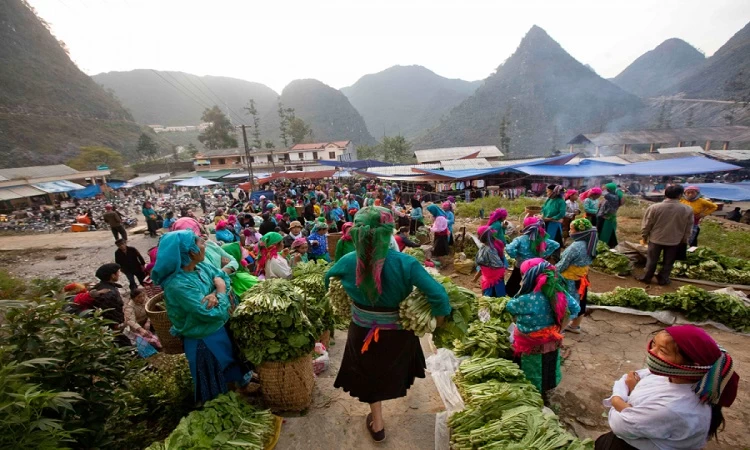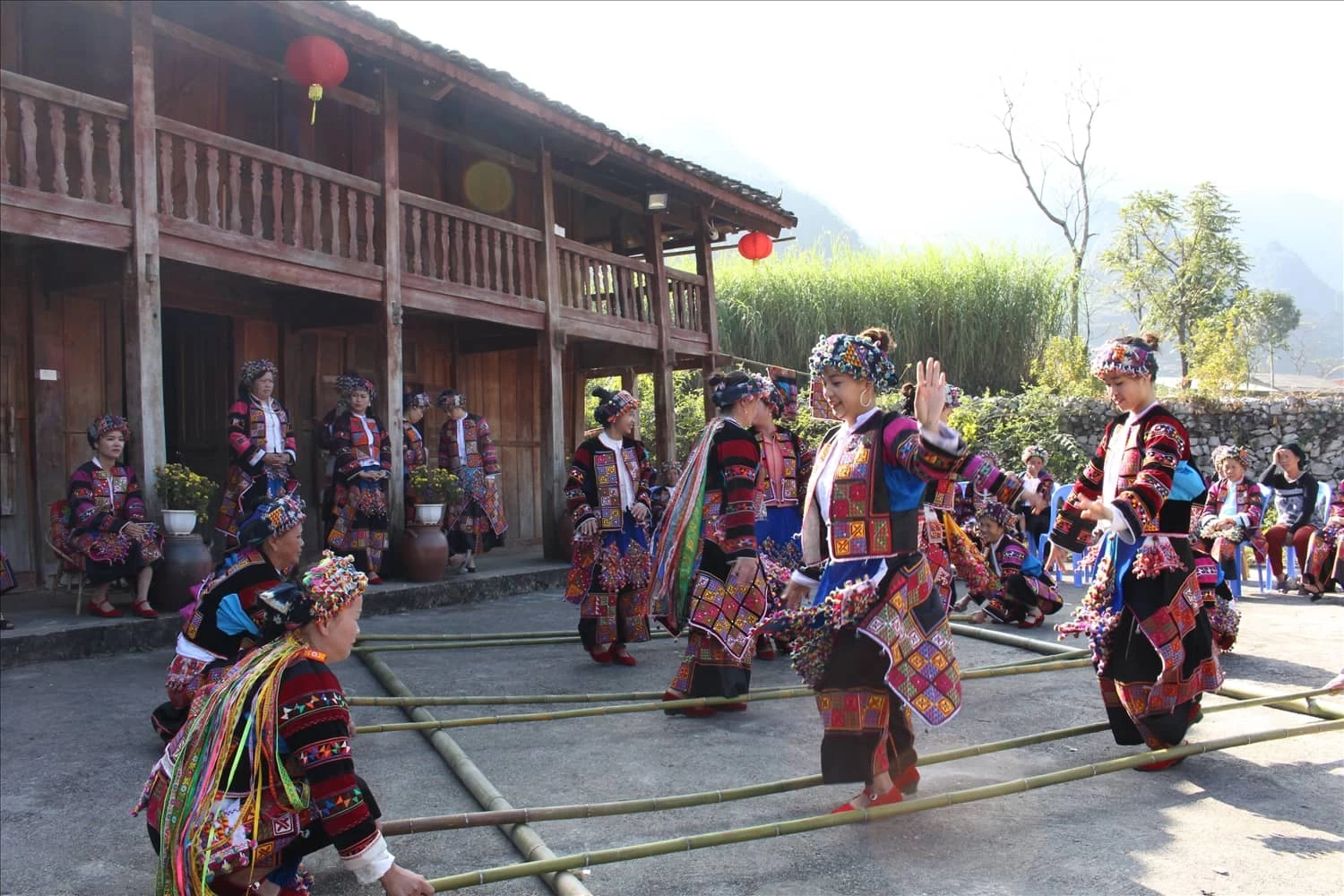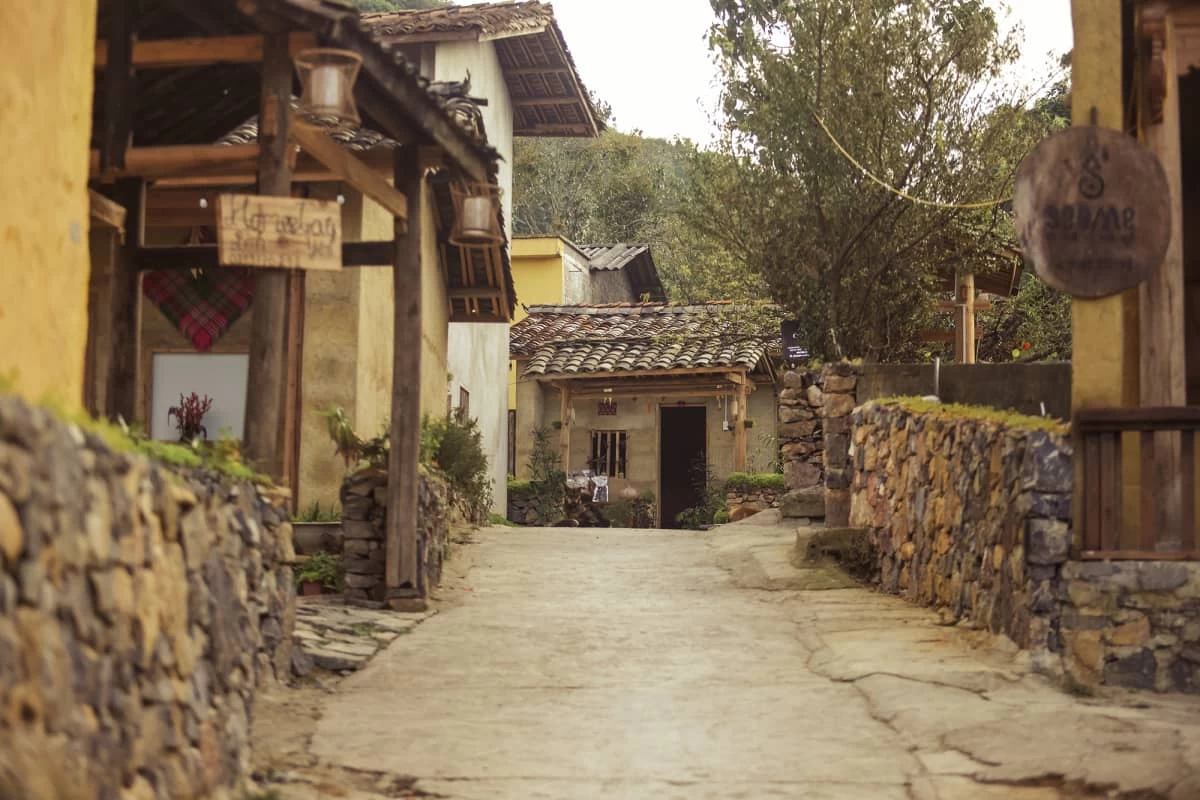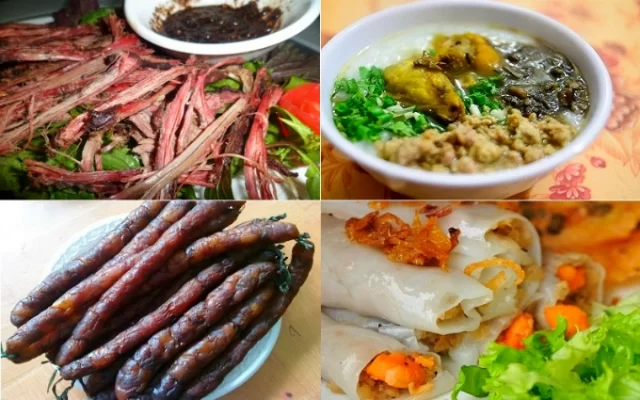
Ha Giang Cuisine
Come along with Ula Travel as we explore the top 10 most delicious dishes in Ha Giang Cuisine. Ha Giang has emerged as one of Vietnam’s most seductive tourism destinations in recent years. In addition to its stunningly gorgeous mountainous landscape, romantic buckwheat flower fields, golden terraced fields during the ripe rice season, and striking bright pink colors.
Ha Giang is also well-known both domestically and abroad for its unique cultural identity, distinctive ethnic group, as well as a synthesis of diverse and rich culinary traditions with specialties that entice diners to the area of the rocky plateau.
1. Mint Honey in Ha Giang cuisine
Mint honey is one of the delectable and healthful dishes of Ha Giang cuisine that may be purchased as gifts for loved ones. Mint honey is a type of honey exploited by the Mong people in the highlands from the nectar of mint flowers, an herb that grows wild in the high mountains of Quan Ba, Yen Minh, Dong Van, and Meo Vac.
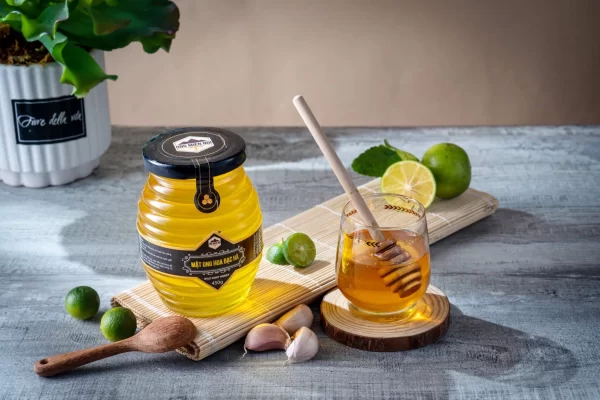
Mint Honey
The natural hue of pure mint honey is a light green with a hint of yellow. The pale and dark colors of the honey also vary depending on the various amounts of mint pollen present. This variety of honey has a distinct scent, a cold sweetness, and a viscosity that embodies flowers. It is regarded as having one of Vietnam’s best tastes in honey.
Mint honey in Ha Giang has a rich sweetness that is different from honey from other regions. It is mild, flavorful, nourishing, and has a unique aroma. The rocky plateau bees compete to gather honey for their nests every September through December during the lunar calendar, when mint blossoms bloom in a single color across the hillsides, mountain slopes, and rocky plateaus. Since mint plants are wildflowers that are abundant on the plateau, swarms of bees are drawn to their purple-pink blossoms, where they gather honey before returning to the hive to make priceless and delectable drips of honey.
2. Au Tau porridge in Ha Giang cuisine
Au Tau porridge is known as the most famous specialty of Ha Giang cuisine that you cannot help but taste. Anyone who has visited Ha Giang will undoubtedly remember this dish. Let’s investigate what makes this cuisine special and well-known with Ula Travel.
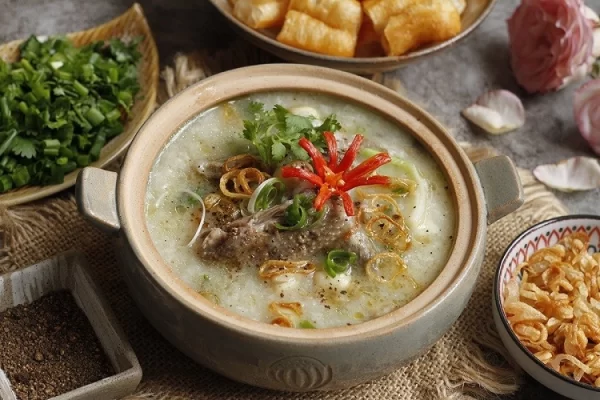
Au Tau porridge
In Ha Giang cuisine, au tau porridge has long been regarded as a specialty dish. Originally a cold-relieving dish for the Mong people, this porridge gradually gained popularity as a specialty dish.
The cooked porridge has a distinct flavor that is meaty, fatty, and fragrant. It has a dark brown color and resembles a bowl of lowland porridge. Au Tau porridge has a bitter taste due to its medicinal essence. But the combination of the sharpness, the soft, meaty chunk of Au Tau, the sweetness of the simmered bone broth, and the aromatic scent of the eggs leaves a lasting scent and sweet taste in the neck, evoking the strange and attractive feeling of Ha Giang cuisine.
While there’s no doubting Au Tau porridge’s appeal, Ula Travel will point out a few things for you:
- Reputable eateries are the best places to consume Au Tau porridge since they have a lot of experience processing and non-toxicizing Au Tau tubers. Definitely, do not purchase it and prepare it yourself.
- Because of its bitter and spicy flavor, au tau porridge is a bit of a finicky dish. To see if you can eat it, you should give it a small try.
- Pregnant women are not advised to consume au tau porridge, so you should be aware of this concern for your safety.
- You cannot eat pears after consuming Au Tau porridge due to the incompatibility of the components. After one night, regular eating is permitted.
3. Thang Den in Ha Giang cuisine
The flavor of the Thang Den combined with the hot ginger juice makes Thang Den a special meal in Ha Giang cuisine. Many visitors trying Ha Giang cuisine have found that this dish is best enjoyed in the evening, when the temperature starts to drop. There’s nothing more inviting in such a setting than a hot, rich, and delicious cake to drink. Sometimes all you need to do to enjoy this dish is sit down at a little roadside diner rather than go to a fancy restaurant.
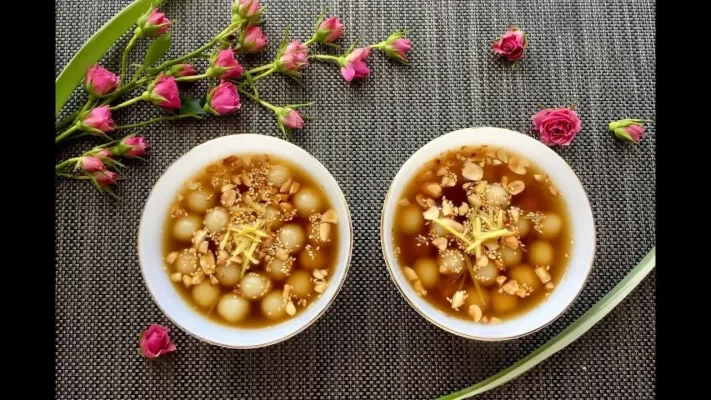
Thang Den
The ingredient for Thang Den is glutinous rice flour. The baker will add vegetarian filling or bean paste, based on personal taste and choice. Their form is reminiscent of Hanoi’s traditional Banh Troi. There will undoubtedly be tourists who wrongly believe these are authentic Banh Troi if you don’t ask the locals. Slightly larger than a thumb, the amaranth cake balls are dropped into a bowl filled with a concoction of ginger, coconut milk, and sweet sugar water. They combine to produce a flavor that is fiery, fatty, and sweet. Roasted peanuts or aromatic sesame balls are added to each bowl of won amaranth to enhance its appearance.
4. Five-color sticky rice in Ha Giang cuisine
The distinctive meal known as “five-colored sticky rice,” which evokes memories of the magnificent mountains, has helped to shape the identity of the highland people. That’s what five-colored sticky rice is known for. Five-color sticky rice is now a delicacy that is hard to miss during Ha Giang cuisine festivals and ethnic minority community events all year long, thanks to its eye-catching appearance and fragrant texture.
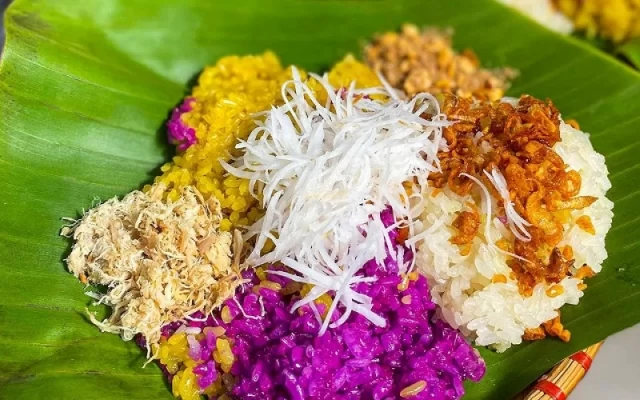
Five-colored sticky rice
The five brilliant colors of five-color sticky rice—white, yellow, purple, red, and blue—combined to provide a tasty and visually appealing dish. This sticky rice is created from a fragrant, ethnically-grown kind of sticky rice. Each fragrant white rice grain is chosen, and the colors of the sticky rice indicate a particular meaning for each one.
Five-color sticky rice has a pleasant aroma; when eaten, it doesn’t require additional seasonings, but it can quickly get hard if stored for an extended period of time. Ethnic individuals pack sticky rice to eat on their way to work in the fields. They bring food from home so they can dine without having to make the long commute to and from work. Ethnic people can perform better at work since eating sticky rice is convenient and filling for a long time.
Ha Giang cuisine is always rich and colorful. Besides, visitors can also enjoy many different flavors of Ha Giang cuisine. A typical example is the five-color sticky rice dish.
5. Hearth-smoked buffalo meat in Ha Giang cuisine
Every family in the northern highland province of Ha Giang has made it a practice to cook meat on the stove because the area is home to numerous ethnic groups. Hearth-smoked buffalo meat has been a staple meal and specialty in Ha Giang cuisine for many generations. Visitors simply cannot miss it when visiting this region.
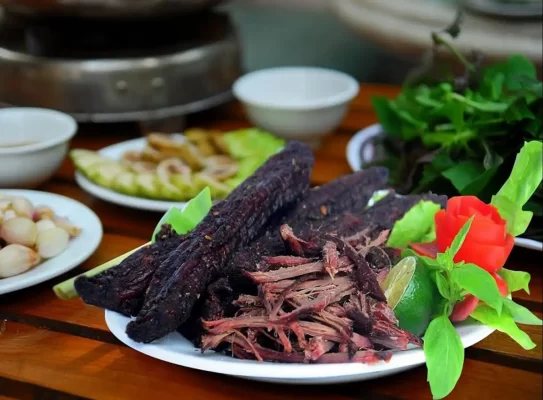
Five-colored sticky rice
The meat chunks will eventually dry out, but will still taste distinctively sweet and fragrant from the spices that were put on them. Hearth-smoked buffalo meat is flavorful and free of preservatives. Every time a tourist gets the chance to try Ha Giang cuisine, this dish becomes their favorite. When they visit Ha Giang, a lot of individuals remember to purchase some as gifts for everyone. Travelers were the ones who popularized kitchen buffalo meat, expanded its market reach, and strengthened the reputation of this specialty meal of Ha Giang cuisine.
How to select mouthwatering hearth-smoked buffalo meat:
- Because the meat fibers are a little coarse, you should get a piece of beef that is dark pink or dark red in color. White fat fibers are frequently present in buffalo meat that has minimal muscle.
- When pressed with your hand, fresh buffalo flesh is sticky, slightly elastic, and has no odd fragrance. The best places to purchase meat are big-box stores, trustworthy distributors, and friends.
- Steer clear of purchasing meat with erratic or strange hues; this type of meat has been pumped with water and is not wet, which is why the outside membrane is very viscous, the meat is not flexible, and when pushed, it feels mushy and has visible juices. safety and health.
6. Carried-under-arm pigs in Hà Giang cuisine
Carried-under-arm pig is an extremely different and interesting specialty in Ha Giang cuisine. People are often wondering how the unique moniker for carried-under-arm pigs came to be. Because the pig’s body is so small, people typically hold the bottle close to their body or hang it under their armpits, which is why they get that name. Moreover, the antiquated farming practices of the highland ethnic groups of Lao Cai, like the Dao, Thai, Mong, etc., gave rise to the carried-under-arm pig.
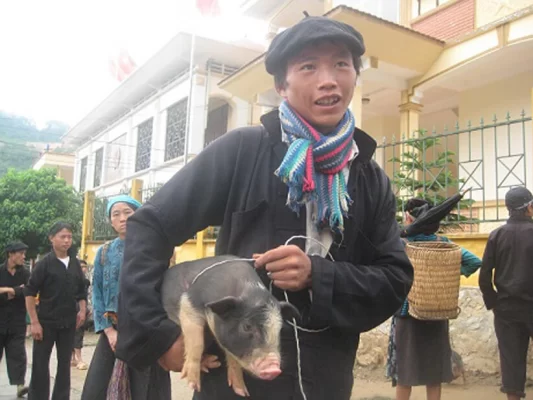
Carried-under-arm pigs
This is basically a regular conventional pig breed that has been crossed with Muong pigs and wild boars; they are very easy to care for. After giving birth, piglets are typically left to wander freely in the sun and rain without access to barns or care. The pigs are occasionally fed corn and cassava tubers, but they must forage for their own food from wild tubers in the garden, woodland, etc.
7. Sour Pho in Ha Giang cuisine
Ha Giang Sour Pho is one of the unusual and distinctive delicacies of the rocky plateau and Ha Giang cuisine that has caused travelers to overlook it. In Ha Giang cuisine, sour pho is a highly favored cuisine that has been handed down for three centuries. This is a Chinese dish that is known as “Luong pan” in Chinese. Eating it offers a nice and pleasant feeling because of its cool and sweet flavor, especially on hot summer days.
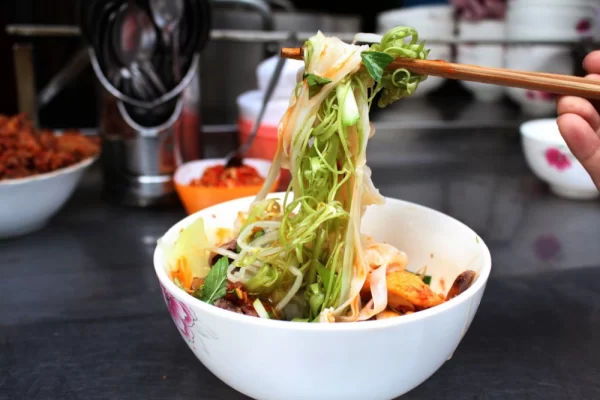
Sour Pho
In the past, ethnic groups frequently served Sour Pho during family feasts, and it was frequently essential. However, these days, sour pho isn’t just a family favorite—it’s also gained popularity and is frequently ordered for breakfast. When visiting Ha Giang and making a pit stop, travelers make sure to have a bowl of sour pho to quench their appetite.
You can eat sour pho at marketplaces on the rocky plateau when visiting Ha Giang. You will have a really unusual experience waiting for the owner to cook a bowl of pho while you sit on the rustic wooden benches, breathe in the lovely aroma, and observe the process of making a full bowl of pho.
8. Dong Van Rice Rolls in Ha Giang cuisine
Strange but familiar, with refinement hidden in every roll, Dong Van rice rolls are one of the highlights not to be missed when trying Ha Giang cuisine.
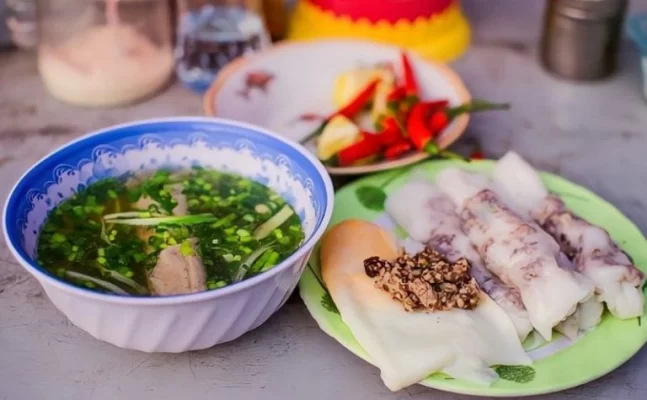
Dong Van Rice Rolls
Dong Van Rice Rolls appear to be very similar to rice rolls from other places at first glance. However, you will experience the dish’s originality when you eat it firsthand. Rice rolls are manually coated. You will notice that the cake is extremely thin, soft, and fragrant—it smells like sticky rice—when you eat it while it’s still hot.
It is essential to have a bowl of dipping sauce in order to fully enjoy the flavor of Dong Van Rice Rolls. Known as broth or stock, this dipping sauce is served in a bowl with small bits of fragrant Thai coriander, finely sliced scallions, and a piece of spicy pork sausage. Simmered bones produce a rich and fragrant broth that smells strongly of fried shallots.
9. Bac Me Bamboo tube-cooked rice in Ha Giang cuisine
Bac Me Bamboo tube-cooked rice is a traditional dish from the people living in Vietnam’s northern mountains. Many people are unfamiliar with the name when they hear and see it. Still, it’s just perfectly cooked rice. However, the people here store rice in bamboo and reed tubes, in contrast to their counterparts in the lowland areas.
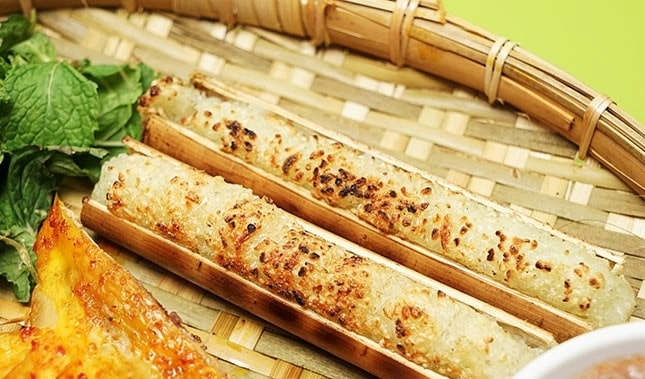
Bac Me Bamboo tube-cooked rice
This is a dish that members of ethnic minorities frequently make to take with them when working in the fields because it is portable, keeps well in storage, and is not easily spoiled. It’s easy to make Bac Me bamboo tube-cooked rice using a few easy steps that save money. Selecting the best sticky rice from the fields and giving it a good soak in water are the essential ingredients. The choice of rice is very important since it has a big impact on how fragrant and tasty lam rice is. After being drained, the sticky rice is uniformly combined with a small amount of salt.
Rice, reed tubes, bamboo stems, and bamboo cut from the mountains are all needed for cooking Bac Me bamboo tube-cooked rice. Once these ingredients are prepared, one end of the bamboo tubes is cut, sticky rice is poured within, and water is added until the top layer of rice is covered.
Then, they firmly tie one end with a knot made of banana or dong leaves. After the bamboo tubes are filled with sticky rice, they are set on a charcoal stove and rotated slowly to let the heat spread uniformly throughout the surface of the tube. Grilling Bac Me bamboo tube-cooked rice takes about an hour, and the rice is ready, delicious, and cooked through when the aroma of cooked rice fills the air.
10. Ha Giang Buckwheat Cakes in Ha Giang cuisine
Locals in Ha Giang harvest buckwheat seeds to sun-dry and grind into powder in order to make Ha Giang buckwheat cakes after each buckwheat blossom season. Despite their small size—roughly half that of black beans—these seeds are incredibly nutritious. You can be sure that hazardous chemicals don’t impact Ha Giang’s buckwheat because it is grown in a natural setting.
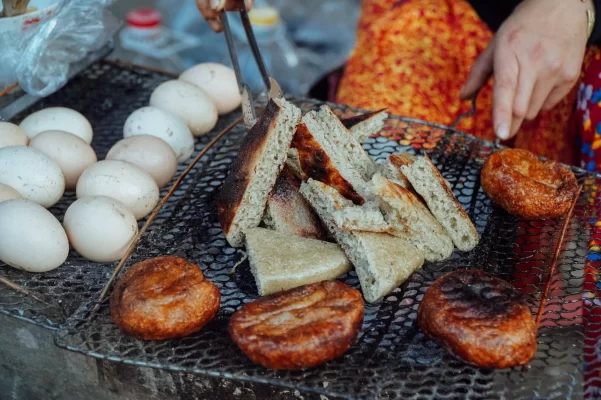
Ha Giang Buckwheat Cakes
There are a few stages involved in making tasty Ha Giang cuisine buckwheat cakes. Before being pulverized by hand, the just-collected buckwheat seeds are properly sun-dried. To prevent lumps in the baked cakes, it is important to grind the buckwheat finely, which takes considerable attention to do. The inhabitants then use water to knead the powder and shape it into round, flat cakes that are roughly the breadth of a palm. To intensify the aroma of the cakes, they are roasted on hot charcoal after steaming until cooked through.
Buckwheat cakes from Ha Giang are delightfully chewy, sweet, fluffy, and velvety. They release a distinct woodland aroma that gets stronger and more aromatic the more you chew on them. When stacked neatly, the cakes’ striking purple color makes an impact that draws in far-off visitors.
If you are ever fortunate enough to travel to Ha Giang during the buckwheat harvest season, make sure you visit the local markets and sample this unique cake of Ha Giang cuisie. These cakes, which are made by the talented hands of the Mong ethnic group, capture the essence of the natural beauty found on the highland plateau.
See more: Ha Giang travel tips




